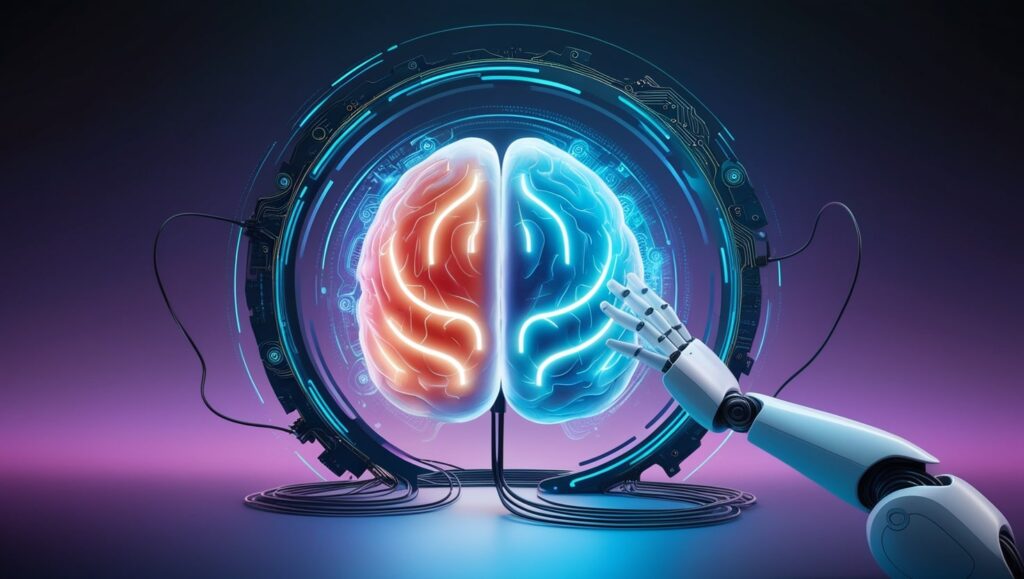
The convergence of neuroscience and artificial intelligence has given rise to a groundbreaking concept: the exocortex. As an external augmentation of the human brain, an exocortex enables advanced cognitive functions by seamlessly integrating artificial intelligence into human thought processes. This revolutionary technology is reshaping how we perceive and interact with AI, setting the stage for profound societal and technological shifts. By enhancing our cognitive abilities and bridging the gap between human intelligence and machine precision, the exocortex is not just a step forward in AI—it’s a leap into a new era of human-AI synergy.
What is an Exocortex?
The term “exocortex” refers to an external cognitive augmentation system that extends the brain’s natural capabilities. Originally conceptualized in science fiction, the exocortex has become a tangible pursuit for neuroscientists and AI researchers. Unlike traditional AI systems, which operate as separate entities, an exocortex works as an extension of the human mind, directly interfacing with neural processes.
Historical Roots
The concept of an exocortex emerged from the imagination of science fiction writers, who envisioned technologies that could amplify human intellect. Today, advancements in brain-computer interfaces (BCIs) and AI are turning these visions into reality, paving the way for transformative applications across industries.
The Science Behind Exocortex Technology
The development of exocortex systems hinges on the integration of neuroscience and cutting-edge AI technologies. Central to this innovation is the use of BCIs, which enable direct communication between the human brain and external devices. By decoding neural signals and transmitting them to AI systems, BCIs facilitate a seamless exchange of information.
Key Technologies Driving Exocortex
- Neural Interfaces: Devices that interpret and translate brain activity into digital commands.
- Artificial Neural Networks: AI algorithms designed to mimic the human brain’s decision-making processes.
- Machine Learning: Adaptive algorithms that allow exocortex systems to personalize their functions based on individual cognitive patterns.
Applications of Exocortex in AI
The potential applications of exocortex technology are vast and transformative. By enhancing human cognitive capabilities, exocortex systems can revolutionize multiple domains:
Healthcare
Exocortex technology can assist in restoring lost cognitive functions, offering hope to individuals with neurological disorders. For example, neuroprosthetics powered by AI can help patients regain memory or motor skills.
Education
Students can benefit from AI-augmented learning tools that adapt to their unique needs, accelerating knowledge acquisition and retention.
Creativity and Innovation
Artists, writers, and innovators can leverage exocortex systems to overcome creative blocks and explore new frontiers of imagination.
Exocortex and the Future of Work
As workplaces become increasingly reliant on data-driven decision-making, exocortex systems offer unprecedented advantages. These technologies can augment problem-solving capabilities, streamline workflows, and enhance productivity across sectors such as finance, engineering, and design.
Ethical Implications in the Workplace
While exocortex systems promise to elevate professional capabilities, they also raise ethical questions about fairness, privacy, and dependence. Organizations must address these challenges to ensure equitable access and responsible usage.
Enhancing Human Cognition with Exocortex
One of the most compelling aspects of exocortex technology is its ability to enhance core cognitive functions such as memory, learning, and creativity. By acting as an external memory bank or a real-time analytical tool, an exocortex can help individuals achieve levels of performance previously thought unattainable.
Real-World Trials
Early experiments with cognitive augmentation have shown promising results. For instance, studies involving BCIs have demonstrated the feasibility of controlling devices through thought alone, setting the stage for more complex applications.
Challenges in Exocortex Development
Despite its potential, the development of exocortex technology faces several hurdles:
- Technological Complexity: Creating systems that seamlessly integrate with human biology is a monumental task.
- Ethical Resistance: Societal skepticism and ethical debates can hinder widespread adoption.
- Regulatory Oversight: Developing international frameworks to govern the use of exocortex systems is essential for fostering innovation while protecting human rights.
Key Players and Innovations
Leading companies and research institutions are driving the development of exocortex technology. Collaborations between neuroscientists and AI experts are yielding groundbreaking innovations, from advanced BCIs to AI algorithms tailored for cognitive augmentation.
Notable Innovations
- Neuralink: Pioneering brain-machine interfaces.
- OpenAI: Developing advanced AI models that could serve as the backbone of exocortex systems.
- University Research Programs: Academic institutions are at the forefront of exploring the ethical and technical dimensions of exocortex technology.
The Future of Exocortex in AI
As exocortex technology evolves, it is poised to redefine the relationship between humans and machines. Predictions for the next decade include:
- Widespread Adoption: Exocortex systems becoming a mainstream tool in professional and personal contexts.
- Global Collaboration: Increased partnerships across countries to advance the technology responsibly.
- Cultural Transformation: Shifting perceptions of intelligence and creativity as humans and AI converge.
Conclusion
The exocortex represents a paradigm shift in artificial intelligence, offering unparalleled opportunities to augment human cognition and transform industries. As we navigate the challenges and ethical considerations of this groundbreaking technology, one thing is clear: the exocortex is not merely an advancement in AI—it is the dawn of a new era in human-AI interaction.
Must Read – How Blockchain Could Preserve Human Consciousness for Eternity

